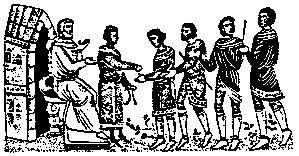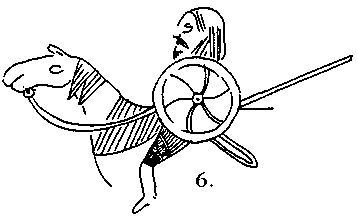Merovingian Dress
Merovingian dress represents a transition from the classical dress of Rome and the barbarian dress of the early Franks and Lombards to the more sophisticated Byzantine-influenced dress of the Carolingians.
Men:
Men wore loose T-shaped tunics sometimes decorated, like those of the Anglo-Saxons with broad bands o various colors (fig. 1). Some tunics were of horizontally stripped material. Other sources mention fitted tunics among the Franks. The gonelle was a knee-length tunic with long or short sleeves (fig. 2). It was generally edged with braid and belted at the waist. In the 7th and 8th centuries it is often shown with wide folds (see "The 'A' Tunic" in EP #4). In the 10th century it is shown with a thick roll at the neck (fig. 3), like the much earlier Gaulish costume. The camisia or undertunic comes from classical times as well as the various over-tunics; the dalmatic (fig. 4) and the colobium, or sleeveless tunic (fig. 5).
Early Franks wore knee-length breeches which were hidden by their tunic. Later they wore tight-fitting breeches made of linen or leather and tied tightly to the legs with the shoe thongs. The 'Hornhausen Horseman' (Fig. 6) wears baggy bloomer-like pants that appear to be tucked into tight-fitting hose or boots at the knees, or to be narrowed by stitching from mid-thigh to the knee. By the ninth century, breeches were worn over linen underpants.
Cloaks...(Fig. 7)
Either rectangular like the pallium or circular like the casula. Men also wore the rheno,
a fur cloak with the fur side out that was decorated with bands of
other skins or fish scales and fastened with a bronze pin. Also worn
was the saie, a short cloak covering only the shoulders (Fig.
8). This later developed a hood and looked rather like the short,
hooded cape of the 14th century.
The clothing of Frankish men required a lot of straps (belts, sword belts, garters, etc.) each of which ended in a decorative oblong tag (fig. 9a). The decoration often consisted of leaf patterns, especially acanthus leaves. Where three straps met, they were joined with a three-lobed metal plate (fig. 9b). These trefoils were picked up by the Norse and used by their women as brooches. Later the Norse made the same shape using their own distinct interlace ornamentation.
Men's hair was worn long, especially men of the royal house, thus their title 'The Long-Haired Kings". Hair was sometimes plaited and worn on top of the head (fig. 10). The back of the neck was sometimes shaved and the hair was often dyed red. The only known male headdress was a narrow band tied behind the head with the two ends falling down the neck behind. This leftover of the Roman period was also worn by the Byzantines (fig. 11).
Men's ceremonial costume consisted of a short tunic of purple with embroidered sleeves, seamless hose and short trousers. A scarf was worn wrapped twice around the waist. The chlamys, also called the Byzantine slit toga, was worn by kings (Fig. A).
One of the most spectacular discoveries from the Merovingian times was found by accident in 1653: the tomb of King Chilperic. It contained many pieces of jewelry as well as armor, weapons, horse harnesses and coins. Unfortunately most of the finds were lost and are only known from descriptions and drawings from the 1700's. One object was a royal cloak decorated with 300 gold cicadas or bees inlaid with garnets!
Not much is known about the actual dress of early Merovingian women. One of the few windows into this comes from the grave of St. Arnegunde or Arnegonde, a Merovingian queen who lived sometime between 550-570 A.D. She wore a knee-length chemise of fine wool and an over-gown of indigo violet satin, also knee-length. Her legs were covered in woolen cloth hose with cross-garters. Over this was worn an ankle-length tunic of red silk lined in linen. This garment was open all the way down the front and was held at the neck and waist with round cloisonne brooches. It had wide long sleeves and was trimmed at the wrist openings (see EP #VI for embroidery details). The feet were covered with black leather boots which fastened with buckles and had metal tags on the strap ends. Laces attached to the shoes served as garters. The garters were also fastened with buckles and had metal tags on the strap ends. Hair was worn long and was covered with a red satin waist-length veil (fig. 12).
In Carolingian times women wore the stole, a long gown pouched at the waist with a leather belt. It had an embroidered band that decorated the neck opening and continued down the front of the dress to the feet. The sleeves were often elbow-length, in which case the undertunic showed (figure 13). Some authors have argued that dresses may have been sleeveless, as Salic Law ordered a fine to be paid by anyone who touched a free-born woman's upper arm. Since, to my knowldge, there are no depictions of naked-armed women, it could also be interpreted as touching an unclothed woman. Fibulae were worn at the shoulders for decoration. Hems might be raised by means of a chain and hook attatched to one of the fibula. The palla was a long scarf wrapped around the shoulders with one end down the front and one end down the back. It was also used to cover the head (fig. 14).
By law, married women's hair had to be covered when they were in public. The ricinium was a veil draped like a turban (fig. 15). The mafors was a large veil covering the head and falling to the feet (fig. 13). Manuscript illuminations show women indoors with their hair covered by nets of woen beatds or precious stones.
Women's shoes were made of leather or linen and were decorated with patterns. They had tongues and were buckled over the instep. They also wore cloth stockings held in place with cross-garters.
 Sources:
Sources:
Bronsted, Johannes The Vikings. Pelican, 1965.
Boucher, Francois 20,000 Years of Fashion. Abrams, NY.
Lasko, Peter The Kingdom of the Franks: Northwest Europe before Charlemange. Thames and Hudson, 1971.
Houston, Mary Anchient Greek, Roman and Byzantine Costume and Decoration. Adam and Charles Black, 1931.
Norris, Herbert Costume and Fashion: Vol. I. J.M. Dent, 1924.
Wilson, David M., ed. The Northern World. Abrams, 1980.
Back to Early Period #7 |
Back to Early Period Index |
Back to PastTimes











